Related Research Articles

Lichenology is the branch of mycology that studies the lichens, symbiotic organisms made up of an intimate symbiotic association of a microscopic alga with a filamentous fungus. Lichens are chiefly characterized by this symbiosis.
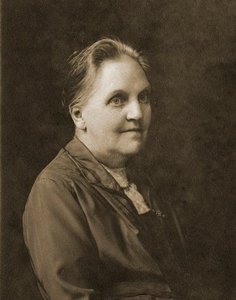
Annie Lorrain Smith was a British lichenologist whose Lichens (1921) was an essential textbook for several decades. She was also a mycologist and founder member of the British Mycological Society, where she served as president for two terms.

Caloplaca is a lichen genus comprising a number of distinct species. Members of the genus are commonly called firedot lichen, jewel lichen. gold lichens, "orange lichens", but they are not always orange, as in the case of C. albovariegata. The distribution of this lichen genus is worldwide, extending from Antarctica to the high Arctic. It includes a portion of northern North America and the Russian High Arctic. There are about thirty species of Caloplaca in the flora of the British Isles.
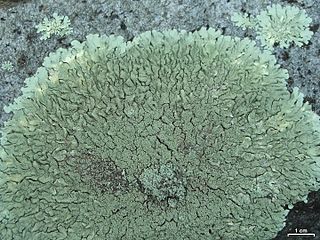
Xanthoparmelia is a genus of foliose lichens in the family Parmeliaceae. This genus of lichen is commonly found in the United States, as well as Australia, New Zealand and Ecuador.

Absconditella is a genus of lichenised fungi in the family Stictidaceae. The genus was circumscribed in 1965 by Czech lichenologist Antonín Vězda, with Absconditella sphagnorum assigned as the type species. Absconditella is characterised by gyalectoid apothecia with a hymenium that is not amyloid, without a dark pigment and thalli containing green algae as photobionts. The genus name means "hidden", a reference to the scant structure of the thallus and its small apothecia.
Pat Wolseley is a botanist and illustrator, specialising in lichen.

Lichens are symbiotic organisms made up of multiple species: a fungus, one or more photobionts and sometimes a yeast. They are regularly grouped by their external appearance – a characteristic known as their growth form. This form, which is based on the appearance of vegetative part of the lichen, varies depending on the species and the environmental conditions it faces. Those who study lichens (lichenologists) have described a dozen of these forms: areolate, byssoid, calicioid, cladoniform, crustose, filamentous, foliose, fruticose, gelatinous, leprose, placoidioid and squamulose. Traditionally, crustose (flat), foliose (leafy) and fruticose (shrubby) are considered to be the three main forms. In addition to these more formalised, traditional growth types, there are a handful of informal types named for their resemblance to the lichens of specific genera. These include alectorioid, catapyrenioid, cetrarioid, hypogymnioid, parmelioid and usneoid.
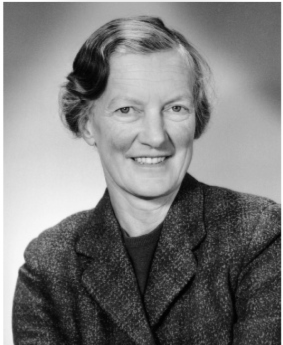
Ursula Katherine Duncan was a botanist with a special interest in mosses and lichens, and a lifelong love and knowledge of flowers. She was entirely self-educated in botany, and corresponded with numerous professional and amateur colleagues, who contributed to her scientific development. She published on bryology, lichenology and vascular plants. The University of Dundee awarded her an honorary doctorate in 1969 for her work as a plant taxonomist and soon after, she was chosen to receive the Linnaean Society's H. H. Bloomer Award for 1973. As well as pursuing her botanical interests, she took charge of the Duncan family's Scottish estate.

Haematomma ochroleucum, also known as yellow bloodstain lichen, is a species of crustose lichenized fungus. First described in 1771 by Noël Martin Joseph de Necker, it has no subspecies, but two named varieties: H. o. var. ochroleucum and H. o. var. porphyrium.
Jack Rodney Laundon was a British lichenologist and became President of the British Lichen Society.
Peter Wilfred James (1930–2014) was an English botanist and lichenologist. He was a pioneer in the study of lichens as environmental indicators, especially of atmospheric pollution.

David John Galloway, FRSNZ was a biochemist, botanist, and lichenologist.
Brian John Coppins is a botanist and lichenologist, considered a world authority on crustose lichens and a leading expert on the genus Micarea.
The British Lichen Society (BLS) was founded in 1958 with the objective of promoting the study and conservation of lichen. Although the society was founded in London, UK, it is also of relevance to lichens worldwide. It has been a registered charity since 1964.
Josef Poelt was a botanist, bryologist and lichenologist. He held the chair in Systematic Botany and Plant Geography at the Free University of Berlin and then was head of the Botanical Institute and Botanical Garden of Graz University, Austria.
Alexandra "Sandy" M. Coppins is a Scottish lichenologist. She was president of the British Lichen Society from 2002 to 2004.
Thomas Douglas (Dougal) Victor Swinscow (1917–1992) was the founder of the British Lichen Society and the scientific journal The Lichenologist. He was also a member of the editorial team of the British Medical Journal and deputy editor from 1964 until 1977.

Robert Lücking is a German lichenologist, known for his extensive research on foliicolous lichens and his significant contributions to the taxonomy, ecology, and biodiversity of fungi and lichens. He earned his master's and PhD from the University of Ulm, focusing on foliicolous lichens. He has received numerous awards for his work, including the Mason E. Hale Award for his doctoral thesis, the Augustin Pyramus de Candolle prize for his monograph, and the Tuckerman Award twice for his publications in the scientific journal The Bryologist.
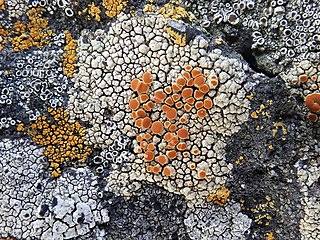
Caloplaca maculata is a species of lichenized fungus endemic to New Zealand.
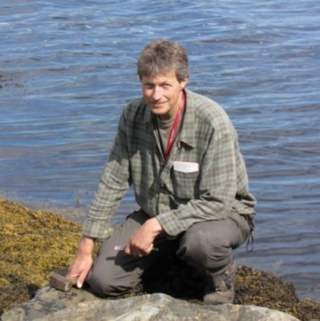
Alan Orange was a British lichenologist. His research interests included lichen taxonomy and phylogenetics, aquatic lichens, and the family Verrucariaceae.
References
- 1 2 3 4 Pedley, Ivan (2022). "Frank Stuart Dobson – June 11th 1934 to December 19th 2021. A personal tribute". British Lichen Society Bulletin. 130 (Summer): 6.
- 1 2 "Lichens An Illustrated Guide to the British and Irish Species". NHBS – Natural History Book Service. Retrieved 24 August 2022.
- 1 2 "2022 AGM and Programme of Talks". BLS. Retrieved 24 August 2022.
- 1 2 "BLS Officers". British Lichen Society. Retrieved 24 August 2022.
- ↑ "Lichens for All – A Month Commemorating the Contributions of Frank Dobson". BLS – News. Retrieved 24 August 2022.
- ↑ "Lichens for All – A Month Commemorating the Contributions of Frank Dobson". BLS.
- ↑ "#MyDobson". Twitter. Retrieved 24 August 2022.
- ↑ "Book Review". The Lichenologist. 43 (4): 377–378. 2011. Retrieved 24 August 2022.